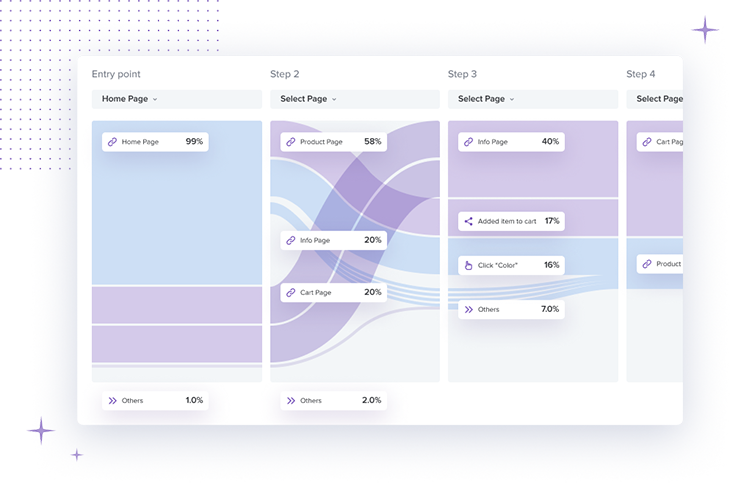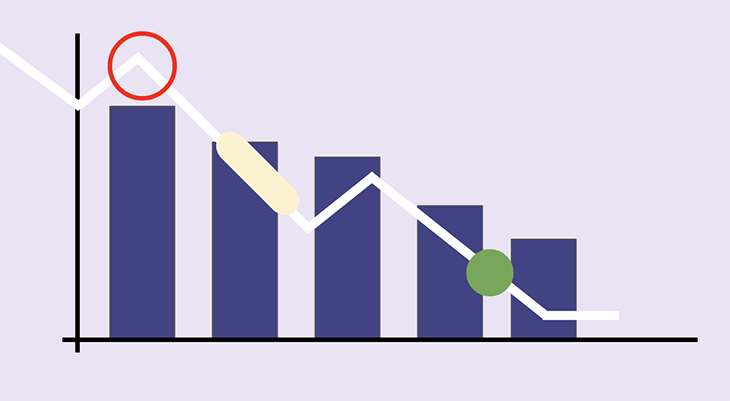One of the opening lines of the first Lord of the Rings movie states, “All that once was is lost, as none now live to remember it.” The reason I bring this up in an article about analytics for product managers is its resemblance to a quote from one of my past mentors, “If you don’t track your feature/new product, it’s as if you have never built it in the first place.”

However, it’s only when we add a quote from philosopher George Santayana — “Those who don’t know history are doomed to repeat it” — that we get the topic for this blog post, customer analytics for product managers.
So what are customer analytics? What are the best practices? Can I shoe-horn any other Lord of the Rings references into an article about, well, how to look at data? Keep reading to find out!
Just so we’re all on the same page, customer analytics involves understanding a multitude of steps that a product manager or their team can take to acquire, transform, analyze, and act on data that illustrate users’ behaviors within their product. This is done to answer one or a couple of fundamental questions:
Based on those, it’s easy to determine that customer analytics is one of the most important aspects of product management.
I can also add here that technically, we could also distinguish “product analytics” here, but in reality, those two mean the same — they both come from observing users’ behavior in the product. However, when looking into users’ analytics we can also include the demographics that might not be obvious from the product usage itself and will require clever tactics to obtain.
Regardless, looking into customer analytics data has a variety of benefits for a product manager:
To put it simply, customer analytics allows the product manager to make informed, data-driven decisions and work in an agile way.
There are a few different categories of customer analytics, including customer journey, customer experience, customer segmentation, customer lifetime value, and customer churn. Let’s explore them in more detail.
This type of customer analytics focuses on understanding how the customers use your product. This can be visualized as a funnel showing the “journey” between different steps of your product (sales funnel) — allowing you to identify pain points and opportunities, and optimize the customer experience:

There is a version of this called “mood journey mapping,” where rather than focusing on the number of users moving from one step of the funnel to another, you try to measure or estimate the users’ mood (from unhappy to happy) during different stages of the journey.
While you will find different definitions for this, I would like to focus here on measuring and/or analyzing the overall sentiment of the product. This would mean measuring the product ratings and users’ comments and acting on those.
A popular metric to measure this is net promoter score, or NPS, which describes how likely the users are to recommend the product to their friends and family.
To calculate the NPS, customers first have to participate in a survey. Customers are categorized into three groups based on the scores they give:
NPS can then be calculated with the following formula:
NPS = % of Promoters – % of Detractors
This type of customer analytics helps you group your customers into relevant categories based on their characteristics, behaviors, demographics, preferences, needs, or the period they first started to use the product.
You can use this type of analytics to tailor your marketing campaigns, offers, and messages to different client segments. You can also use it to identify your most valuable customers (i.e. “power users”) and try to discover what led them to this status. This way you can potentially promote specific product behaviors that are likely to turn a regular user into a powerful one.
With customer lifetime value, you can estimate the total revenue or profit that a user will generate in the product throughout the whole period they use it.
Customer lifetime value analysis will help you to prioritize your marketing and sales efforts (should you invest in growing the monthly active users, MAU, or focus on upselling the loyal users), allocate your resources, and optimize your pricing strategies.
Churn analytics shows when and how many customers are canceling their subscriptions or simply stopping to use your product. The point of this analysis is to find areas of the products that cause the most users to quit and fix them. It’s essential to monitor this data to have a healthy product.
If more users quit the product than join it every month, it means that the budget should be dedicated to preventing churn rather than burning the marketing budget.
Let me share a relatable example of how I work with customer analytics in my product management courses. Initially, they were available on a well-known course marketplace and I spent a year developing my MVP. When the first course was released, among other activities, I fanatically observed the reviews. I needed that for two reasons:
Only by analyzing those reviews (that often turned into longer product discovery sessions) was I able to indeed confirm my plans, identify a small number of important topics I didn’t address, and also fix one single, though critical, fault: the title and main promise of the course.
On release, it was called the “Practical product manager course.” For me, that meant I included actionable advice that I worked out based on my experience and that students can safely copy. What I didn’t realize is that the word “practical” means different things for different students and when the implied promise was not met, the course was poorly rated. A simple name tweak addressed this issue.
Now, when my courses are hosted on my website, I use an analytics and monitoring tool (specifically Google Analytics) to monitor the traffic and see where I get my students from. This way I know where I need to focus my content generation energy. It also helped me to investigate whether there are any bugs on the website and finally, see how much I can shorten the sales funnel. There are a number of tools out there that can help you do this, including LogRocket, Google Analytics, and more.
Thus, after three weeks of monitoring and asking new students for feedback, I confidently and with good data could make an official launch just last week with no bugs, issues, or unhappy students!
Now that you know what customer analytics are, let me provide some tips on how to best work with them:
That’s right. All the data and all the analysis in the world will lead to time wasted if you are not looking for the right answers about your product. Thus:
Only equipped with that context will you be able to start asking the right questions. I know it’s general, so here are the exact questions for your product:
I’m kidding, this is just an article! How would I know that? How to ask the right questions for your product is a complicated story for another time, but I can assure you: great product managers are those who do ask the right questions.
Let’s move on to the next piece of advice.
While you may be asking the right questions, the next risk is asking too many questions at the same time. Just like how your code developers are more effective when their sprint has fewer goals, you will be able to better analyze customer data if you focus on a few key questions.
This is mostly about those analyses that require a lot of time and in-depth effort. Of course, you will be also monitoring minor aspects (like ratings, key metrics, or reviews) on a regular basis, but even here the advice holds.
Create a single page where all the data you want to monitor is well visible and gives you everything you need at a glance. Then, you can…
Data can be beautiful, though it is not the point. The point is to be able to differentiate its importance very quickly and make it easy to understand what a specific figure is trying to say.
For example, your main product dashboard can show your key metrics in a gigantic font and a color reflecting the trend (green for rising and red for decreasing). Your product funnel can be a “boring” table showing how many people made it between different stages of the journey or it can be a visual burnout chart.
The idea, at least for those customer metrics you need to keep an eye on, is to build something you can look at while having your morning coffee at the office and have a reliable, eagle-eye view of the state of the product:

As I already mentioned, as a product manager you will have tons of customer data to look at. If you follow this article, you will likely limit the scope of data answers you seek. However, when coupled with managing the product’s development, it may be too much work to do that and deal with those basic questions.
Thus, don’t be afraid to delegate some of the burdens to your analysts and developers if the answers you seek will contribute enough value. It’s also a good idea to keep a priority Jira or Trello backlog of analytics projects you’d like to conduct. This way you can better prioritize them and tackle them one by one.
Though data are numbers that should always be factual, it’s also true that a pair of a human and a dog has an average of three legs. Thus, make sure you have a level of skepticism when looking at your data — there might be bugs in the data-gathering process, there might be weird outliers that contaminate the data, or you might be looking at a seasonal drop.
The last one is an interesting thing I learned the hard way — if you operate on a distant market and you notice a significant drop in your daily metrics, make sure your clients didn’t have a bank holiday that’s not observed in your country. This insight saved me tons of stress in my life ever since I first identified this as a potential point of failure.
Those are the few generic, but educated and actionable, pieces of advice I can offer as a data-driven product manager. However, times are changing and we are getting more and more data that we can analyze with more and more ease every day. Thus, let’s look at the future of customer analytics.
Well, it shouldn’t be a shocker that in the (near?) future, AI will take over and will help you analyze data and build the dashboards you need. However, so far, no such tool exists that will give you instant answers to all your analytics challenges.
The hype “GPT” technology looks impressive, but remember what it really is: an AI that is brilliant at predicting the text that should be written based on the prompt. Even if you ask it to analyze data, it won’t do it. It will compile an answer based on the text, not numerical, data it finds and give it a green light to lots of hallucinations — an event where the AI confidently makes up answers with no base in facts or merit.
However, as time goes on, I’m sure there will be AIs popping up to do specific tasks like finding the most vulnerable spots in your funnel, identifying trends and seasonalities or highlighting anomalies, and setting up automated alerts. Thus, only when such specialized bots exist, a truly Star Trek-like AI may appear, where you ask a question and it will come back to you with an informed and actionable answer.
While AI appears to be moving forward at an incredible speed, it will be many years before such tech will emerge and all privacy concerns will resolve. Until then, we will be still doing stuff manually, though faster and with the help of AI agents that will aid specific use cases. Other than that, there won’t be significant changes in the customer analytics process.
However, it is still an evolving process, so don’t expect your product’s data analysis to remain the same for long — look into evolving it gradually with new tools and knowledge, so it will always serve you as best as possible!
As this article slowly sets the sails to Valinor (here’s the promised Lord of the Rings reference), let me leave you with this final summary and piece of advice:
Customer analytics is an essential part of a product manager’s work. Focus on it and make it a part of your day!
It might sound trivial, I know that. But I have also seen my and other PMs’ calendars being full of meetings from dusk till dawn. I felt the pressure of preparing tickets so they are ready before the sprint launches and, early in my career, I prioritized creating actionable tasks rather than focusing on the hypothesis, tracking, and analysis part of it.
Rookie mistake.
Quality over quantity and deadlines, my dear fellow product managers. Again, “If you don’t track your feature/new product, it’s as if you have never built it in the first place.”
Thank you.

LogRocket identifies friction points in the user experience so you can make informed decisions about product and design changes that must happen to hit your goals.
With LogRocket, you can understand the scope of the issues affecting your product and prioritize the changes that need to be made. LogRocket simplifies workflows by allowing Engineering, Product, UX, and Design teams to work from the same data as you, eliminating any confusion about what needs to be done.
Get your teams on the same page — try LogRocket today.

A practical five minute revenue estimation method to help product managers compare ideas, drop low impact features, and prioritize smarter.

A practical guide for PMs who want to stop being bottlenecks, delegate smarter, and lead teams effectively with a clear ownership framework.

Stop letting unreliable data block features. Treat data as inventory to track quality, ownership, and ship with confidence.

Learn why slide decks slow teams down and explore better tools like whiteboards, PRDs, and prototypes to improve collaboration and alignment.